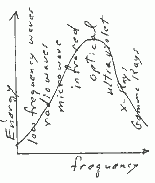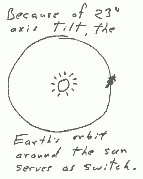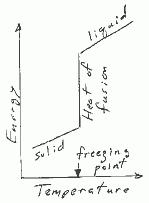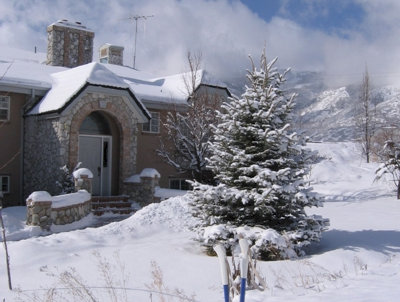The home is basically designed to be warm in the winter and cool in the
summer. There is plenty of solar energy. The problem is how to store it
and optimally use it for self sufficiency.
Nature gives us three methods of heating: convective, conductive and
radiant; radiant is by far the most pleasant and desirable. Using these three
methods, the home is designed so that each room is almost a zone to itself. The
numbers before each point correspond to the illustration above.
 1.
Trombe Wall
1.
Trombe Wall
The plot to the right characterizes the energy from the sun
as a function of the frequency of the electromagnetic waves. The direct sun
provides about 1 1/2 kilowatts of power per square meter. The southern high
living-room windows are positioned to let in the winter sun. The glass lets in
the optical band of frequencies, which are readily absorbed by the dark brick
on the south facing side of the trombe wall. The wall -- being at room
temperature -- radiates in the infrared region of the frequency spectrum --
keeping the home warm at night, since it radiates from the center of the home.
This infrared heat is like the warm glow from a bed of coals in a camp fire.
Since the infrared frequencies are reflected by the glass, they are trapped in
the house -- being absorbed readily by the human body.  The roof extends out to the south above these special windows providing
complete shading in the summer, and so that the sun rays start heating the
trombe wall about the first of October and turn off about the end of March.
The roof extends out to the south above these special windows providing
complete shading in the summer, and so that the sun rays start heating the
trombe wall about the first of October and turn off about the end of March.
[click here for more information on Trombe
Walls]
2. Solarium
Partially cantilevered out to the south of the living room
is a solarium. In the winter this room will often exceed 90o F.
Since hot air rises, this room creates an upward pressure. Since cold air
drops, the air on the north side of the house creates a downward pressure. The
five convection tubes connecting the solarium with the north side of the house
allow the hot air to flow providing warm air on the north side of the trombe
wall (kitchen, dinning area, etc.) There are return air ducts in the floor
joist as well as through the door ways when they are opened. In principle, one
could grow vegetables in the winter months in the solarium -- letting it act
as a greenhouse.
3. Photo-Voltaic
The two arrays of photo-voltaic cells can supply 24 volts
at 50 amperes (more than 1 kilowatt of power). This energy is stored in
batteries. The refrigerator and fans run off of DC power. Inverters supply
other emergency parts of the house: the water pumps, deep freeze, kitchen
power, and the office and shop.
4. Hot Water Panels
The hot-water supply system consists of six 4'X 8'
collecting panels set at an optimum angle (60o) for this latitude
(about 40o N). This system is powered by the photo-voltaics. It has
temperature sensors and three pumps. The first pump carries propylene-glycol
through the panels when they get sufficiently hot to carry the solar energy to
a heat exchanger. A second pump circulates culinary water through the heat
exchanger back into three storage tanks -- two large ones (250 gallons) and
one 50 gallon standard water heater. The latter has propane backup capability,
but almost never turns on. This system supplies all of our culinary hot water
needs and provides, via the third pump, convective-radiant heat for the three
bathrooms and the NW (Sterling's room) downstairs bedroom.
5. Eutectic Salt Chamber
Potentially the most efficient heating system of the six is
the eutectic salt chamber. The salt being used is sodium sulfate deca-hydrate
(NaSO4 • H2O -- Glauber's salt).  At the right is a curve representing the energy stored as a function of
temperature of a substance as it transitions from solid to liquid
(phase-change). For example, it takes 80 calories to melt one gram of ice. In
reverse, one gram (1 cc) of water gives off 80 calories as it turns to ice;
this is called the heat of fusion. This heat of fusion principle is often used
to save orchard blossoms from freezing if the temperature drops below freezing
in the Spring by sprinkling them with water. As the water freezes, it gives
off this heat of fusion and saves the blossoms. Thermal storage using water is
not nearly so efficient, as water only stores one calory per gram per degree
centigrade. Glauber's salt has the nice property that it melts at 90o
F and has about 83 calories per gram. It does not take a lot of salt to heat
several rooms. The salt in the chamber is stored in black tubes to pull in the
day-time sun so that the salt melts. At night as the salt freezes at 90o
F, the air is heated around the tubes like a radiator, which then rises, and
like the solarium forces air through the floor joist -- dropping down in the
cooler rooms needing heat with return air going through ducting under the
floors.
At the right is a curve representing the energy stored as a function of
temperature of a substance as it transitions from solid to liquid
(phase-change). For example, it takes 80 calories to melt one gram of ice. In
reverse, one gram (1 cc) of water gives off 80 calories as it turns to ice;
this is called the heat of fusion. This heat of fusion principle is often used
to save orchard blossoms from freezing if the temperature drops below freezing
in the Spring by sprinkling them with water. As the water freezes, it gives
off this heat of fusion and saves the blossoms. Thermal storage using water is
not nearly so efficient, as water only stores one calory per gram per degree
centigrade. Glauber's salt has the nice property that it melts at 90o
F and has about 83 calories per gram. It does not take a lot of salt to heat
several rooms. The salt in the chamber is stored in black tubes to pull in the
day-time sun so that the salt melts. At night as the salt freezes at 90o
F, the air is heated around the tubes like a radiator, which then rises, and
like the solarium forces air through the floor joist -- dropping down in the
cooler rooms needing heat with return air going through ducting under the
floors.
More about Eutectic Salt Chamber
6. Berm Insulation
The principle of a berm home (underground) is that if one
goes about 2 meters deep (6 feet), the underground temperature is pretty much
constant day and night and over the course of the year. In this area, it is
about 54o F. One can imaging an insulated dome with the outside
footings insulated down about 2 m. The temperature in this dome would remain
54o without doing anything else. Our home has three layers of
insulation (R-factor of 37), and the concrete foundation is insulated on the
outside down sufficiently deep in order to capture this ponderous heat source
from the earth. All that is necessary is to add about 14 additional degrees of
heating to make our home comfortable. The fireplace is more for ambience than
for necessity.

7. Passive Solar Air
Conditioner
The passive solar air conditioner works on the following
principle. Two black chimneys have been placed on either end of the solarium.
On the East, South and West surface of these chimneys are glass panels with
black tin sheets a couple of inches inside the glass surface. The black-tin
gets hot in the summer sun, and with the door at the base of the chimney being
opened during the summer the hot air created by the hot tin rises creating an
upward flow -- venting out the louvers at the top of each chimney. The air is
replace by cool air coming from the downstairs and in particular from a 50
foot underground tube which pulls air from an evaporatively cooled shaded area
to the north-west of the house. The solarium vent tubes operate in reverse --
allowing the hot air from the house to flow through the black chimneys.
8.
Geodesic Dome
In ~2006, the Allans built a geodesic-dome green house www.growingspaces.com
that has produced tomatoes and greens year around. The design includes a
large tank of water as a thermal mass to keep the temperatures above freezing
through the night. Dave uses a solar panel to power a small fan for
circulation. The venting panel on the top is also solar controlled.